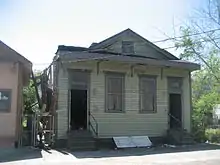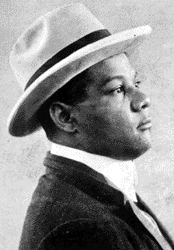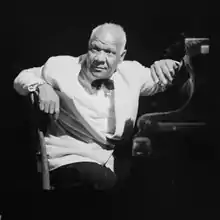Sidney Bechet
Sidney Joseph Bechet[1] (May 14, 1897 – May 14, 1959) was an American jazz saxophonist, clarinetist, and composer. He was one of the first important soloists in jazz, beating trumpeter Louis Armstrong to the recording studio by several months.[2] His erratic temperament hampered his career, and not until the late 1940s did he earn wide acclaim.
Sidney Bechet | |
|---|---|
.jpg.webp) Photographic portrait of Bechet in New York, 1947, by William P. Gottlieb | |
| Background information | |
| Birth name | Sidney Joseph Bechet |
| Born | May 14, 1897 New Orleans, Louisiana, United States |
| Died | May 14, 1959 (aged 62) Garches, France |
| Genres | Jazz, Dixieland |
| Occupation(s) | Musician, composer |
| Instruments | Clarinet, soprano saxophone |
| Years active | 1908–1957 |
| Associated acts | Louis Armstrong, Tommy Ladnier |
Biography

Bechet was born in New Orleans in 1897 to a middle-class Creole of color family. His older brother, Leonard Victor Bechet, was a full-time dentist and a part-time trombonist and bandleader. Bechet learned several musical instruments that were kept around the house, mostly by teaching himself; he decided to specialize in the clarinet (which he played almost exclusively until about 1919). At the age of six, he started playing with his brother's band at a family birthday party, debuting his talents to acclaim. Later in his youth, Bechet studied with Lorenzo Tio, "Big Eye" Louis Nelson Delisle, and George Baquet.[3]
Bechet played in many New Orleans ensembles using the improvisational techniques of the time (obbligatos with scales and arpeggios and varying the melody). He performed in parades with Freddie Keppard's brass band, the Olympia Orchestra, and in John Robichaux's dance orchestra. From 1911 to 1912, he performed with Bunk Johnson in the Eagle Band of New Orleans and in 1913–14 with King Oliver in the Olympia Band. From 1914 to 1917 he was touring and traveling, going as far north as Chicago and frequently performing with Freddie Keppard. In the spring of 1919, he traveled to New York City where he joined Will Marion Cook's Syncopated Orchestra. Soon after, the orchestra traveled to Europe; almost immediately upon arrival, they performed at the Royal Philharmonic Hall in London. The group was warmly received, and Bechet was especially popular.[3] While in London, he discovered the straight soprano saxophone and developed a style unlike his clarinet tone. His saxophone sound could be described as emotional, reckless, and large. He often used a broad vibrato, similar to what was common among some New Orleans clarinetists at the time. On July 30, 1923, he began recording. The session was led by Clarence Williams, a pianist and songwriter, better known at that time for his music publishing and record producing. Bechet recorded "Wild Cat Blues" and "Kansas City Man Blues". "Wild Cat Blues" is in a ragtime style with four 16-bar themes, and "Kansas City Man Blues" is a 12-bar blues.[4]
In 1919, Ernest Ansermet, a Swiss conductor of classical music, wrote a tribute to Bechet, one of the earliest (if not the first) to a jazz musician from the field of classical music, linking Bechet's music with that of Bach.[5]

On September 15, 1925, Bechet and other members of the Revue Nègre, including Josephine Baker, sailed to Europe, arriving at Cherbourg, France, on September 22. The revue opened at the Théâtre des Champs-Élysées[6] in Paris on October 2. He toured Europe with various bands, reaching as far as Russia in mid-1926. In 1928, he led his small band at Chez Bricktop in Montmartre, Paris.
He was imprisoned in Paris for eleven months.[7][8] In his autobiography, he wrote that he accidentally shot a woman when he was trying to shoot a musician who had insulted him. He had challenged the man to duel and said, "Sidney Bechet never plays the wrong chord."[9] After his release, he was deported to New York, arriving soon after the stock market crash of 1929. He joined Noble Sissle's orchestra, which toured in Germany and Russia.
In 1932, Bechet returned to New York City to lead a band with Tommy Ladnier. The band, consisting of six members, performed at the Savoy Ballroom. He went on to play with Lorenzo Tio and also got to know trumpeter Roy Eldridge.[10]
In 1938 "Hold Tight, Hold Tight (Want Some Seafood Mama)", commonly known as "Hold Tight", was composed by Bechet's guitarist Leonard Ware and two session singers with claimed contributions from Bechet himself. The song became known for its suggestive lyrics and then for a series of lawsuits over songwriter royalties.
In 1939, Bechet and the pianist Willie "The Lion" Smith led a group that recorded several early versions of what was later called Latin jazz, adapting traditional méringue, rhumba and Haitian songs to the jazz idiom. On July 28, 1940, Bechet made a guest appearance on the NBC Radio show The Chamber Music Society of Lower Basin Street, playing two of his showpieces ("Shake It and Break It" and "St. Louis Blues") with Henry Levine's Dixieland band. Levine invited Bechet into the RCA Victor recording studio (on 24th Street in New York City), where Bechet lent his soprano sax to Levine's traditional arrangement of "Muskrat Ramble". On April 18, 1941, as an early experiment in overdubbing at Victor, Bechet recorded a version of the pop song "The Sheik of Araby", playing six different instruments: clarinet, soprano saxophone, tenor saxophone, piano, bass, and drums. A hitherto unissued master of this recording was included in the 1965 LP Bechet of New Orleans, issued by RCA Victor as LPV-510. In the liner notes, George Hoeffer quoted Bechet:
I started by playing The Sheik on piano, and played the drums while listening to the piano. I meant to play all the rhythm instruments, but got all mixed up and grabbed my soprano, then the bass, then the tenor saxophone, and finally finished up with the clarinet.
In 1944, 1946, and 1953 he recorded and performed in concert with the Chicago jazz pianist and vibraphonist Max Miller, private recordings that are part of Miller's archive and have never been released. These concerts and recordings are described in John Chilton's biography Sidney Bechet: The Wizard of Jazz.[11]
With jobs in music difficult to find, he opened a tailor shop with Ladnier. They were visited by musicians and played in the back of the shop. In the 1940s, Bechet played in several bands, but his financial situation did not improve until the end of that decade. By the end of the 1940s, Bechet had tired of struggling to make music in the United States. His contract with Jazz Limited, a Chicago-based record label, was limiting the events at which he could perform (for instance, the label would not permit him to perform at the 1948 Festival of Europe in Nice). He believed that the jazz scene in the United States had little left to offer him and was getting stale.[10] In 1950 he moved to France, after his performance as a soloist at the Paris Jazz Fair caused a surge in his popularity in that country, where he easily found well-paid work. In 1951, he married Elisabeth Ziegler in Antibes.

In 1953, he signed a recording contract with Disques Vogue that lasted for the rest of his life.[10] He recorded many hit tunes, including "Les Oignons", "Promenade aux Champs-Elysees", and the international hit "Petite Fleur". He also composed a classical ballet score in the late Romantic style of Tchaikovsky called La Nuit est une sorcière ("The Night Is a Witch"). Some existentialists in France took to calling him le dieu ("the god").[12]
Shortly before his death, Bechet dictated his autobiography, Treat It Gentle, to Al Rose, a record producer and radio host. He had worked with Rose several times in concert promotions and had a fractious relationship with him. Bechet's view of himself in his autobiography was starkly different from the one Rose knew. "The kindly old gentleman in his book was filled with charity and compassion. The one I knew was self-centered, cold, and capable of the most atrocious cruelty, especially toward women."[13] Although embellished and frequently inaccurate, Treat It Gentle remains a staple account for the "insider's view of the New Orleans tradition."[14]
Bechet died in Garches, near Paris, of lung cancer on May 14, 1959 on his 62nd birthday. He is buried in a local cemetery.[1]
Bechet played a jazz musician in three films, Série noire,[15] L'inspecteur connaît la musique and, Quelle équipe![16]
His playing style was intense and passionate and had a wide vibrato. He was also known to be proficient at playing several instruments and a master of improvisation (both individual and collective). Bechet liked to have his sound dominate in a performance, and trumpeters found it difficult to play alongside him.[10][2]
On June 25, 2019, The New York Times Magazine listed Sidney Bechet among hundreds of artists whose material was reportedly destroyed in the 2008 Universal fire.[17]
Personal life
Bechet was Catholic.[18]
Awards
- DownBeat magazine Hall of Fame, 1968[19]
Discography
Singles
- "Texas Moaner Blues", with Louis Armstrong, 1924
- "Cake Walkin' Babies from Home", with Red Onion Jazz Babies, 1925
- "Got the Bench, Got the Park (But I Haven't Got You)", 1930
- "Blues in Thirds", 1940
- "Dear Old Southland", 1940
- "Egyptian Fantasy", 1941
- "Muskrat Ramble", 1944
- "Blue Horizon", 1944
- "Petite Fleur", 1959
Further reading
- American Peoples Encyclopedia Yearbook (1953). p. 542.
- Bechet, Sidney (1960). Treat It Gentle. Twayne. Reprint, Da Capo, 1978.
- Hoefer, George (1946). Article in Metronome Magazine, December 1946.
References
- "Sidney Joseph Bechet". Findagrave.com.
- Yanow, Scott. "Sidney Bechet". AllMusic.com. Retrieved 2011-06-28.
- Porter, Lewis; Ullman, Michael (1988). "Sidney Bechet and His Long Song". The Black Perspective in Music. 16 (2): 135–150. doi:10.2307/1214805. JSTOR 1214805.
- Yanow, Scott. "Sidney Bechet: Profiles in Jazz". Syncopatedtimes.com. Retrieved 6 April 2020.
- Porter, Lewis; Ullman, Michael (1988). "Sidney Bechet and His Long Song". The Black Perspective in Music. 16 (2): 135–150. doi:10.2307/1214805. JSTOR 1214805.
- Shack, William A. (2001). Harlem in Montmartre. Berkeley: University of California Press. p. 35. ISBN 0-520-22537-6.
- Cohassey, John. "Sidney Bechet". www.encyclopedia.com. Retrieved 10 September 2018.
- Palmer, Robert (1976). Sidney Bechet: Master Musician (Media notes). Bluebird Records.
- "The struggle in Paris". My Life - Sidney Bechet. Retrieved 10 September 2018.
- Horricks, Raymond (1991). Profiles in Jazz. New Brunswick, New Jersey: Transaction. pp. 1–10.
- Chilton, John (1987). Sidney Bechet: The Wizard of Jazz. Macmillan. ISBN 0333443861.
- Filan, Kenaz (2011). "Appendix 2". The New Orleans Voodoo Handbook. Rochester, Vermont: Destiny Books. ISBN 978-1594774355.
- Rose, Al (1987). I Remember Jazz: Six Decades Among the Great Jazzmen. Baton Rouge: Louisiana State University Press. pp. 60–65. ISBN 0-8071-2571-7.
- Stephen Cottrell (2013). The Saxophone (Yale Musical Instrument Series). Yale Musical Instrument Series. p. 187.
- "Série noire". Allocine.fr. Retrieved 2015-12-30.
- "Ah, quelle équipe!". Allocine.com. Retrieved 2015-12-30.
- Rosen, Jody (25 June 2019). "Here Are Hundreds More Artists Whose Tapes Were Destroyed in the UMG Fire". The New York Times. Retrieved 23 July 2019.
- Hill, Gary (2007-04-30). "Historic jazz church in New Orleans clings to life". Reuters. Retrieved 2020-12-03.
- "Radio Swiss Jazz - Music database". Retrieved 2018-04-01.
External links
| Wikimedia Commons has media related to Sidney Bechet. |